Detecting Sustainability of Desertification Reversion: Vegetation Trend Analysis in Part of the Agro-Pastoral Transitional Zone in Inner Mongolia, China
Abstract
:1. Introduction
2. Materials and Methods
2.1. Study Area
2.2. Materials
2.2.1. MODIS 16-Day Composite NDVI Product
2.2.2. Land Use/Cover and Desertification Data
2.2.3. Meteorological Data and Groundwater Record
2.2.4. Socioeconomic Data
2.3. Method
2.3.1. Trend Analysis
2.3.2. Path Analysis
3. Results and Discussion
3.1. Spatial-Temporal Process of Annual NDVI
3.2. Effect of Climate Variables on NDVI
3.3. Effect of Human Activities on NDVI
3.4. The Sustainability of Desertification Reversion in the HQA
4. Conclusions
Acknowledgments
Author Contributions
Conflicts of Interest
References
- Reynolds, J.F.; Smith, D.M.S.; Lambin, E.F.; Turner, B.L.; Michael, M.; Batterbury, S.P.J.; Downing, T.E.; Hadi, D.; Fernández, R.J.; Herrick, J.E. Global Desertification: Building a Science for Dryland Development. Science 2007, 316, 847–851. [Google Scholar] [CrossRef] [PubMed]
- D’Odorico, P.; Bhattachan, A.; Davis, K.F.; Ravi, S.; Runyan, C.W. Global desertification: Drivers and feedbacks. Adv. Water Resour. 2013, 51, 326–344. [Google Scholar] [CrossRef]
- Verón, S.R.; Paruelo, J.M.; Oesterheld, M. Assessing desertification. J. Arid Environ. 2006, 66, 751–763. [Google Scholar] [CrossRef]
- Open Working Group Proposal for Sustainable Development Goals. Available online: https://sustainabledevelopment.un.org/focussdgs.html (accessed on 7 January 2015).
- Murphy, B.P.; Bowman, D.M.J.S. What controls the distribution of tropical forest and savanna? Ecol. Lett. 2012, 15, 748–758. [Google Scholar] [CrossRef] [PubMed]
- Elmendorf, S.C.; Henry, G.H.; Hollister, R.D.; Björk, R.G.; Bjorkman, A.D.; Callaghan, T.V.; Collier, L.S.; Cooper, E.J.; Cornelissen, J.H.; Day, T.A.; et al. Global assessment of experimental climate warming on tundra vegetation: Heterogeneity over space and time. Ecol. Lett. 2012, 15, 164–175. [Google Scholar] [CrossRef] [PubMed]
- Lehmann, C.E.R.; Archibald, S.A.; Hoffmann, W.A.; Bond, W.J. Deciphering the distribution of the savanna biome. New Phytol. 2011, 191, 197–209. [Google Scholar] [CrossRef] [PubMed]
- Hessburg, P.F.; Reynolds, K.M.; Salter, R.B.; Dickinson, J.D.; Gaines, W.L.; Harrod, R.J. Landscape Evaluation for Restoration Planning on the Okanogan-Wenatchee National Forest, USA. Sustainability 2013, 5, 805–840. [Google Scholar] [CrossRef]
- Fang, J.; Yang, Y.; Ma, W.; Mohammat, A.; Shen, H. Ecosystem carbon stocks and their changes in China’s grasslands. Sci. China Life Sci. 2010, 53, 757–765. [Google Scholar] [CrossRef] [PubMed]
- Li, X.R. Influence of variation of soil spatial heterogeneity on vegetation restoration. Sci. China Earth Sci. 2005, 48, 2020–2031. [Google Scholar] [CrossRef]
- Yan, Y.; Xin, X.; Xu, X.; Wang, X.; Yang, G.; Yan, R.; Chen, B. Quantitative effects of wind erosion on the soil texture and soil nutrients under different vegetation coverage in a semiarid steppe of northern China. Plant Soil 2013, 369, 585–598. [Google Scholar] [CrossRef]
- Li, X.; Zhang, Z.; Huang, L.; Wang, X. Review of the ecohydrological processes and feedback mechanisms controlling sand-binding vegetation systems in sandy desert regions of China. Chin. Sci. Bull. 2013, 58, 1483–1496. [Google Scholar] [CrossRef]
- Zhao, X.; Zuo, X.; Huang, G.; Huang, Y.; Wang, S.; Luo, Y.; Huang, W.; Qu, H.; Mao, W.; Lian, J. Desertification Reversion in Relation to Land Use Change and Climate in Naiman County, Inner-Mongolia, China. Sci. Cold Arid Reg. 2010, 2, 15–20. [Google Scholar]
- Zuo, X.; Zhao, X.; Zhao, H.; Zhang, T.; Guo, Y.; Li, Y.; Huang, Y. Spatial heterogeneity of soil properties and vegetation-soil relationships following vegetation restoration of mobile dunes in Horqin Sandy Land, Northern China. Plant Soil 2009, 318, 153–167. [Google Scholar] [CrossRef]
- Wang, T. Atlas of Sandy Desert and Aeolian Desertification in Northern China; Science Press: Beijing, China, 2014. [Google Scholar]
- Mao, D.; Wang, Z.; Luo, L.; Ren, C. Integrating AVHRR and MODIS data to monitor NDVI changes and their relationships with climatic parameters in Northeast China. Int. J. Appl. Earth Obs. 2012, 18, 528–536. [Google Scholar] [CrossRef]
- Fu, X.; Tang, C.; Zhang, X.; Fu, J.; Jiang, D. An improved indicator of simulated grassland production based on MODIS NDVI and GPP data: A case study in the Sichuan province, China. Ecol. Indic. 2014, 40, 102–108. [Google Scholar] [CrossRef]
- Brown, M.E.; Pinzón, J.E.; Didan, K.; Morisette, J.T.; Tucker, C.J. Evaluation of the consistency of long-term NDVI time series derived from AVHRR, SPOT-Vegetation, SeaWiFS, MODIS, and Landsat ETM+ sensors. IEEE Trans. Geosci. Remote Sens. 2006, 44, 1787–1793. [Google Scholar] [CrossRef]
- Maselli, F.; Papale, D.; Chiesi, M.; Matteucci, G.; Angeli, L.; Raschi, A.; Seufert, G. Operational monitoring of daily evapotranspiration by the combination of MODIS NDVI and ground meteorological data: Application and evaluation in Central Italy. Remote Sens. Environ. 2014, 152, 279–290. [Google Scholar] [CrossRef]
- Zhu, Z.; Piao, S.; Myneni, R.B.; Huang, M.; Zeng, Z.; Canadell, J.G.; Ciais, P.; Sitch, S.; Friedlingstein, P.; Arneth, A.; et al. Greening of the Earth and its drivers. Nat. Clim. Chang. 2016, 6, 791–795. [Google Scholar] [CrossRef]
- Zhao, H.; He, Y.; Zhou, R.; Su, Y.; Li, Y.; Drake, S. Effects of desertification on soil organic C and N content in sandy farmland and grassland of Inner Mongolia. Catena 2009, 77, 187–191. [Google Scholar] [CrossRef]
- Liu, X.M.; Zhao, H.L.; Zhao, A.F. Wind-Sandy Environment and Vegetation in the Horqin Sandy Land, China; Science Press: Beijing, China, 1996. (In Chinese) [Google Scholar]
- Land Processes Distributed Active Archive Center. Available online: https://lpdaac.usgs.gov/dataset_discovery/modis/modis_products_table/mod13q1 (accessed on 14 April 2014).
- National Land Cover Dataset. Available online: http://www.resdc.cn/ (accessed on 12 January 2016).
- Zhu, Z.; Liu, S. Desertification and Its Control in China; Science Press: Beijing, China, 1989. (In Chinese) [Google Scholar]
- Duan, H.C.; Tao, W.; Xian, X.; Liu, S.L.; Jian, G. Dynamics of aeolian desertification and its driving forces in the Horqin Sandy Land, Northern China. Environ. Monit. Assess. 2014, 186, 6083–6096. [Google Scholar] [CrossRef] [PubMed]
- Suzuki, R.; Xu, J.; Motoya, K. Global analyses of satellite-derived vegetation index related to climatological wetness and warmth. Int. J. Climatol. 2006, 26, 425–438. [Google Scholar] [CrossRef]
- Xu, W. Kira’s Temperature Indices and Their Application in the Study of Vegetation. Chin. J. Ecol. 1985, 4, 35–39. (In Chinese) [Google Scholar]
- Mishra, U.; Lal, R.; Slater, B.; Calhoun, F.; Liu, D.S.; Meirvenne, M.V. Predicting soil organic carbon stock using profile depth distribution functions and ordinary kriging. Soil Sci. Soc. Am. J. 2009, 73, 614–621. [Google Scholar] [CrossRef]
- Inner Mongolia Autonomous Regional Bureau of Statistics. Inner Mongolia Statistical Yearbook 2001; China Statistics Press: Beijing, China, 2001. (In Chinese)
- Inner Mongolia Autonomous Regional Bureau of Statistics. Inner Mongolia Statistical Yearbook 2002; China Statistics Press: Beijing, China, 2002. (In Chinese)
- Inner Mongolia Autonomous Regional Bureau of Statistics. Inner Mongolia Statistical Yearbook 2003; China Statistics Press: Beijing, China, 2003. (In Chinese)
- Inner Mongolia Autonomous Regional Bureau of Statistics. Inner Mongolia Statistical Yearbook 2004; China Statistics Press: Beijing, China, 2004. (In Chinese)
- Inner Mongolia Autonomous Regional Bureau of Statistics. Inner Mongolia Statistical Yearbook 2005; China Statistics Press: Beijing, China, 2005. (In Chinese)
- Inner Mongolia Autonomous Regional Bureau of Statistics. Inner Mongolia Statistical Yearbook 2006; China Statistics Press: Beijing, China, 2006. (In Chinese)
- Inner Mongolia Autonomous Regional Bureau of Statistics. Inner Mongolia Statistical Yearbook 2007; China Statistics Press: Beijing, China, 2007. (In Chinese)
- Inner Mongolia Autonomous Regional Bureau of Statistics. Inner Mongolia Statistical Yearbook 2008; China Statistics Press: Beijing, China, 2008. (In Chinese)
- Inner Mongolia Autonomous Regional Bureau of Statistics. Inner Mongolia Statistical Yearbook 2009; China Statistics Press: Beijing, China, 2009. (In Chinese)
- Inner Mongolia Autonomous Regional Bureau of Statistics. Inner Mongolia Statistical Yearbook 2010; China Statistics Press: Beijing, China, 2010. (In Chinese)
- Inner Mongolia Autonomous Regional Bureau of Statistics. Inner Mongolia Statistical Yearbook 2011; China Statistics Press: Beijing, China, 2011. (In Chinese)
- Inner Mongolia Autonomous Regional Bureau of Statistics. Inner Mongolia Statistical Yearbook 2012; China Statistics Press: Beijing, China, 2012. (In Chinese)
- Inner Mongolia Autonomous Regional Bureau of Statistics. Inner Mongolia Statistical Yearbook 2013; China Statistics Press: Beijing, China, 2013. (In Chinese)
- Inner Mongolia Autonomous Regional Bureau of Statistics. Inner Mongolia Statistical Yearbook 2014; China Statistics Press: Beijing, China, 2014. (In Chinese)
- Inner Mongolia Autonomous Regional Bureau of Statistics. Inner Mongolia Statistical Yearbook 2015; China Statistics Press: Beijing, China, 2015. (In Chinese)
- Inner Mongolia Autonomous Regional Bureau of Statistics. Inner Mongolia Statistical Yearbook 2016; China Statistics Press: Beijing, China, 2016. (In Chinese)
- Sayemuzzamana, M.; Jhab, M.K. Seasonal and annual precipitation time series trend analysis in North Carolina, United States. Atmos. Res. 2014, 137, 183–194. [Google Scholar] [CrossRef]
- Ay, M.; Kisi, O. Investigation of trend analysis of monthly total precipitation by an innovative method. Theor. Appl. Climatol. 2014, 120, 617–629. [Google Scholar] [CrossRef]
- Wright, S. The Method of Path Coefficients. Ann. Math. Stat. 1934, 5, 161–215. [Google Scholar] [CrossRef]
- Du, J.; Li, M.; Yuan, Z.; Guo, M.; Song, J.; Xie, X.; Chen, Y. A decision analysis model for KEGG pathway analysis. BMC Bioinform. 2016, 17, 407. [Google Scholar] [CrossRef] [PubMed]
- Zhang, J.; Zhang, L.; Xu, C.; Liu, W.; Qi, Y.; Wo, X. Vegetation variation of mid-subtropical forest based on MODIS NDVI data—A case study of Jinggangshan City, Jiangxi Province. Acta Ecol. Sin. 2014, 34, 7–12. [Google Scholar] [CrossRef]
- Duan, H.; Yan, C.; Tsunekawa, A.; Song, X.; Li, S.; Xie, J. Assessing vegetation dynamics in the Three-North Shelter Forest region of China using AVHRR NDVI data. Environ. Earth Sci. 2011, 64, 1011–1020. [Google Scholar] [CrossRef]
- An, Y.; Gao, W.; Gao, Z.; Liu, C.; Shi, R. Trend analysis for evaluating the consistency of Terra MODIS and SPOT VGT NDVI time series products in China. Front. Earth Sci. 2015, 9, 125–136. [Google Scholar] [CrossRef]
- Lian, J.; Zhao, X.; Zuo, X.; Wang, S.; Wang, X.; Luo, Y. Land cover changes and the effects of cultivation on soil properties in Shelihu wetland, Horqin Sandy Land, Northern China. J. Arid Land 2013, 5, 71–79. [Google Scholar] [CrossRef]
- Wang, T.; Xue, X.; Zhou, L.; Guo, J. Combating Aeolian Desertification in Northern China. Land Degrad. Dev. 2015, 26, 118–132. [Google Scholar] [CrossRef]
- Chen, X.; Su, Y.; Liao, J.; Shang, J.; Dong, T.; Wang, C.; Liu, W.; Zhou, G.; Liu, L. Detecting significant decreasing trends of land surface soil moisture in eastern China during the past three decades (1979–2010). J. Geophys. Res. Atmos. 2016, 121, 5177–5192. [Google Scholar] [CrossRef]
- Wang, L.; Yuan, X.; Xie, Z.; Wu, P.; Li, Y. Increasing flash droughts over China during the recent global warming hiatus. Sci. Rep. 2016, 6, 30571. [Google Scholar] [CrossRef] [PubMed]
- Chuai, X.W.; Huang, X.J.; Wang, W.J.; Bao, G. NDVI, temperature and precipitation changes and their relationships with different vegetation types during 1998–2007 in Inner Mongolia, China. Int. J. Climatol. 2013, 33, 1696–1706. [Google Scholar] [CrossRef]
- Stefanc, D.; Max, R.; Marcfp, B. Coupling microscale vegetation-soil water and macroscale vegetation-precipitation feedbacks in semiarid ecosystems. Glob. Chang. Biol. 2007, 13, 671–678. [Google Scholar]
- Yue, X.; Zhang, T.; Zhao, X.; Liu, X.; Ma, Y. Effects of rainfall patterns on annual plants in Horqin Sandy Land, Inner Mongolia of China. J. Arid Land 2016, 8, 389–398. [Google Scholar] [CrossRef]
- Xu, D.; Li, C.; Xiao, S.; Ren, H. The dynamics of desertification in the farming-pastoral region of North China over the past 10 years and their relationship to climate change and human activity. Catena 2014, 123, 11–22. [Google Scholar] [CrossRef]
- Tao, S.; Fang, J.; Zhao, X.; Zhao, S.; Shen, H.; Hu, H.; Tang, Z.; Wang, Z.; Guo, Q. Rapid loss of lakes on the Mongolian Plateau. Proc. Natl. Acad. Sci. USA 2015, 112, 2281–2286. [Google Scholar] [CrossRef] [PubMed]
- Cheng, G.D.; Xin, L.I. Integrated research methods in watershed science. Sci. China Earth Sci. 2015, 58, 1159–1168. [Google Scholar] [CrossRef]
- Huo, Z.; Feng, S.; Kang, S.; Li, W.; Chen, S. Effect of climate changes and water-related human activities on annual stream flows of the Shiyang river basin in arid north-west China. Hydrol. Process. 2008, 22, 3155–3167. [Google Scholar] [CrossRef]
- Cheng, G.; Xin, L.; Zhao, W.; Xu, Z.; Qi, F.; Xiao, S.; Xiao, H. Integrated study of the water–ecosystem–economy in the Heihe River Basin. Natl. Sci. Rev. 2014, 1, 413–428. [Google Scholar] [CrossRef]
- Waller, P.; Yitayew, M. Center Pivot Irrigation Systems. In Irrigation and Drainage Engineering; Springer International Publishing: Cham, Switzerland, 2016; pp. 209–228. [Google Scholar]
- Cao, S.; Chen, L.; Shankman, D.; Wang, C.; Wang, X.; Zhang, H. Excessive reliance on afforestation in China’s arid and semi-arid regions: Lessons in ecological restoration. Earth Sci. Rev. 2011, 104, 240–245. [Google Scholar] [CrossRef]
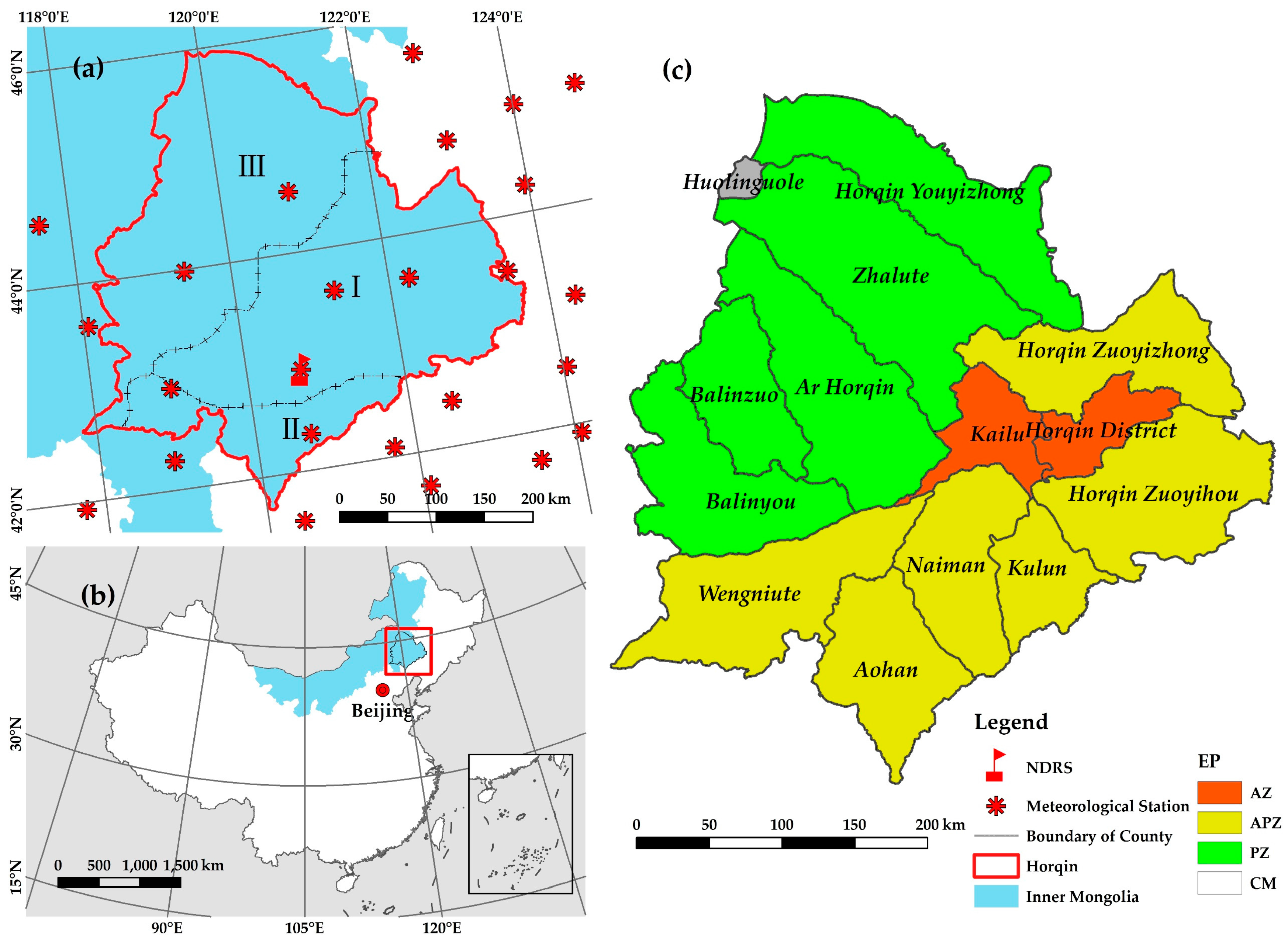
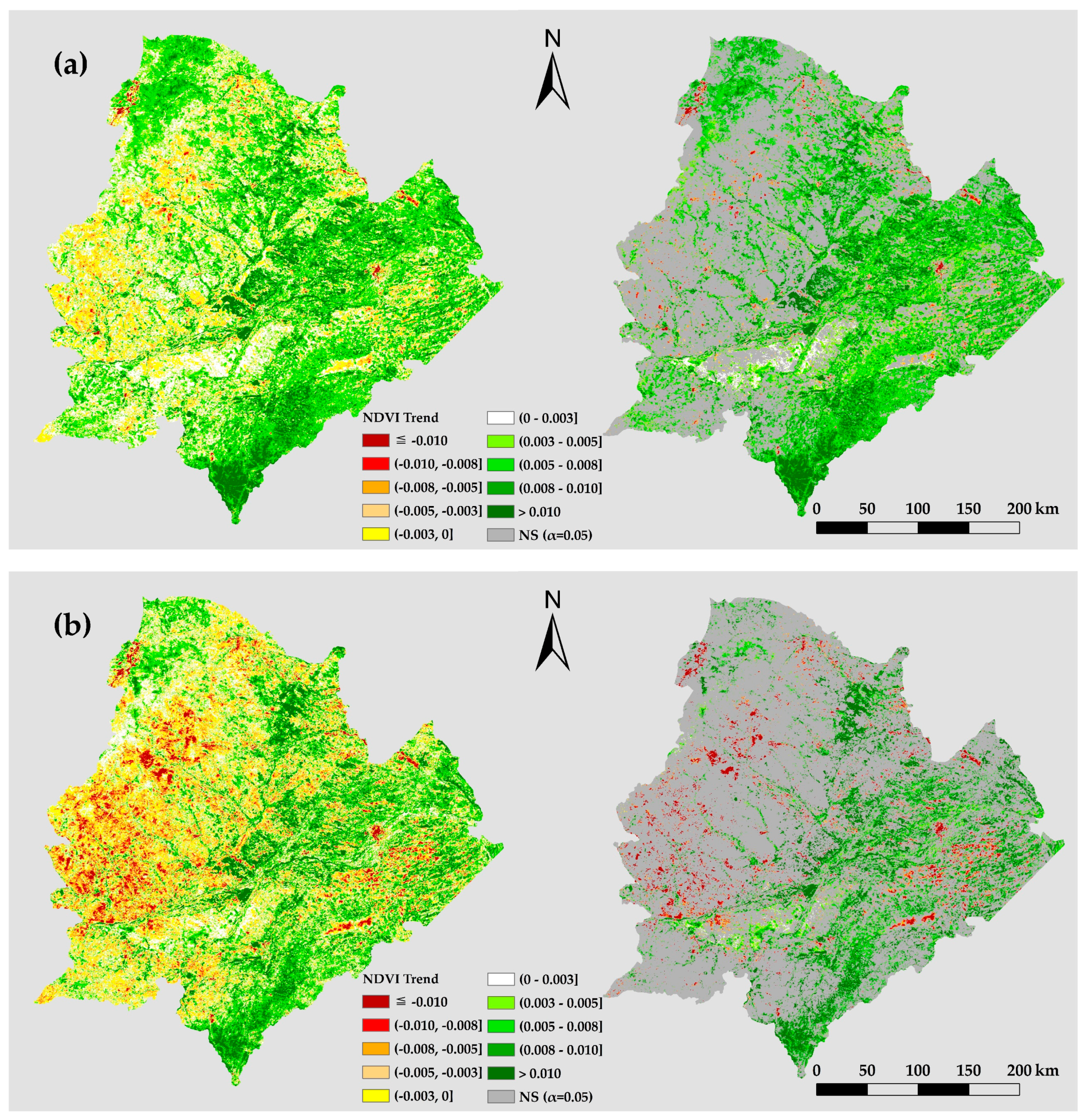
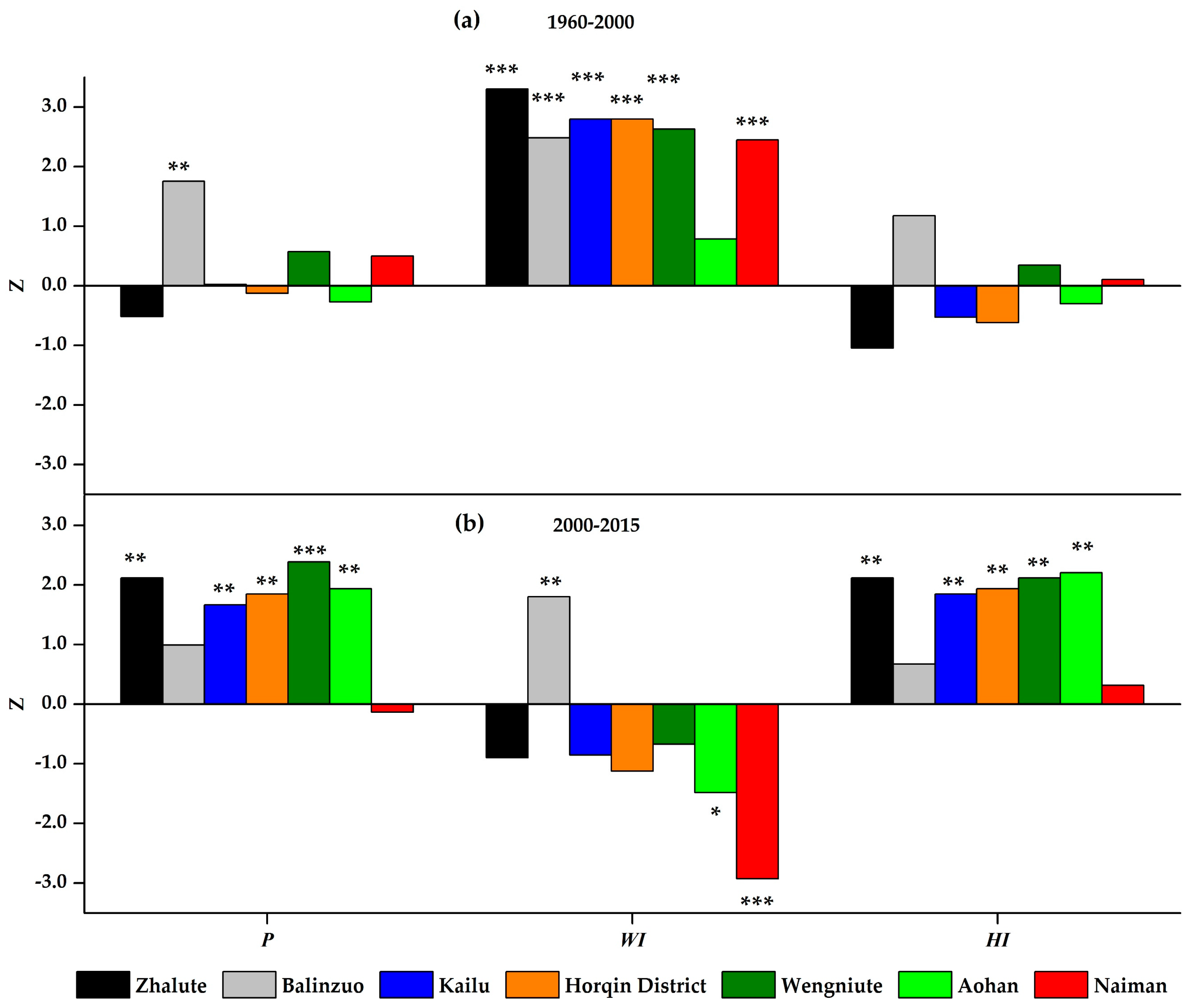
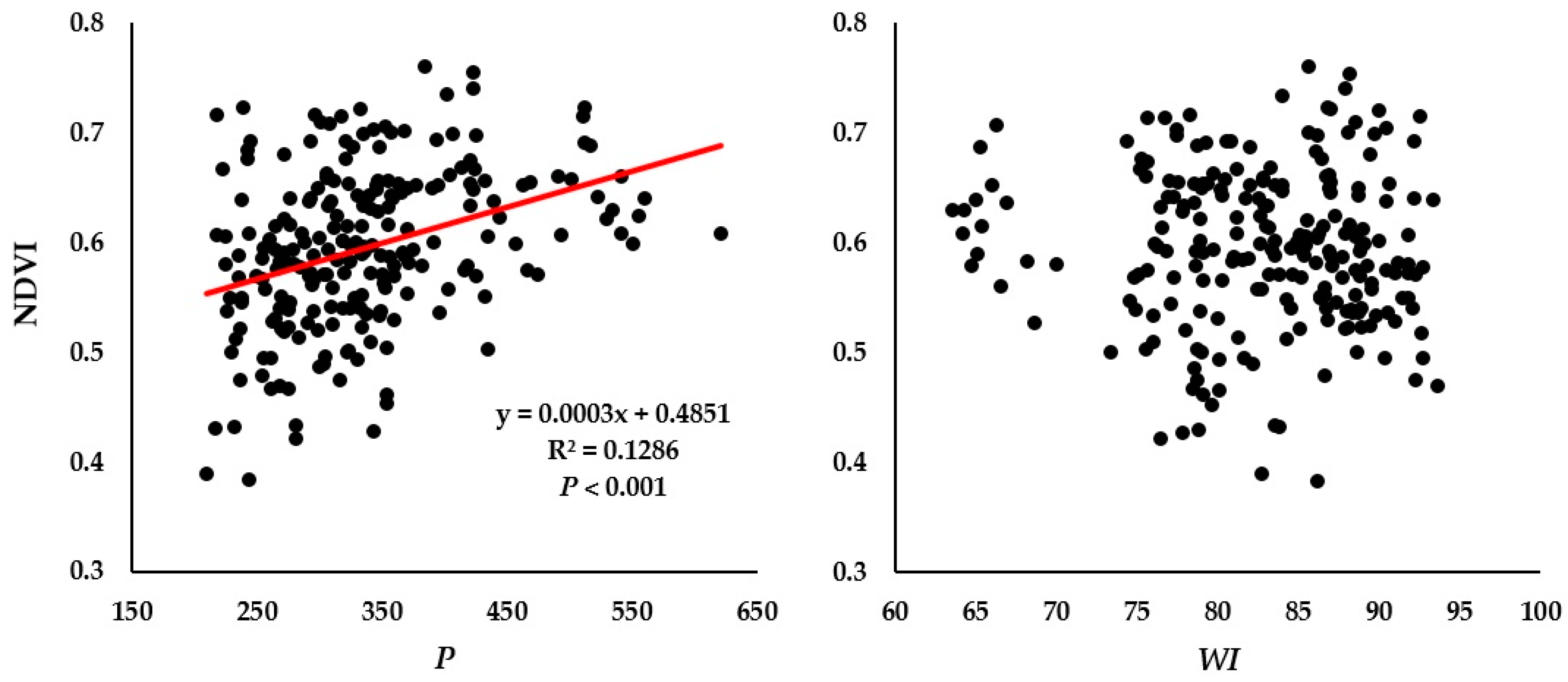

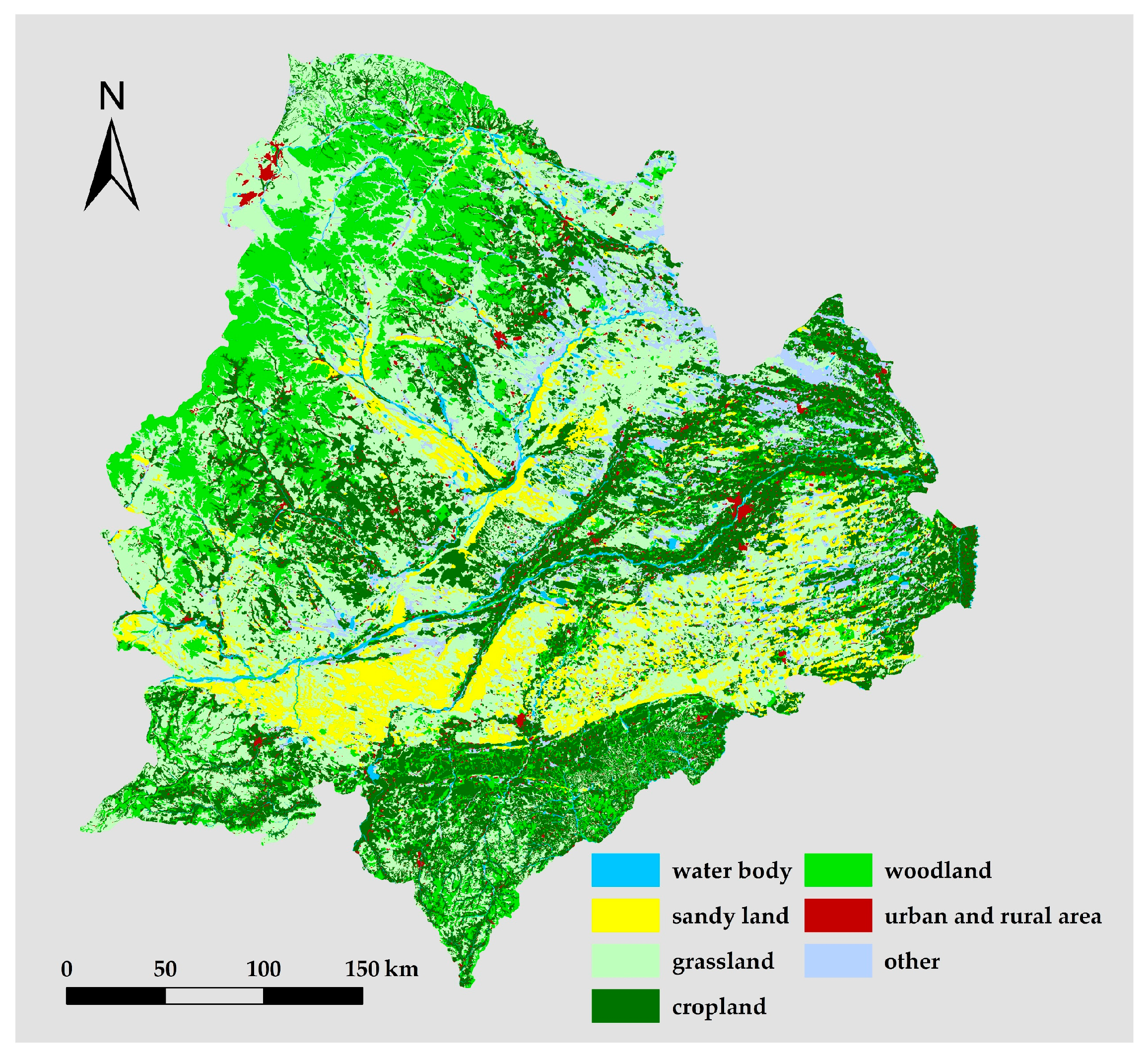
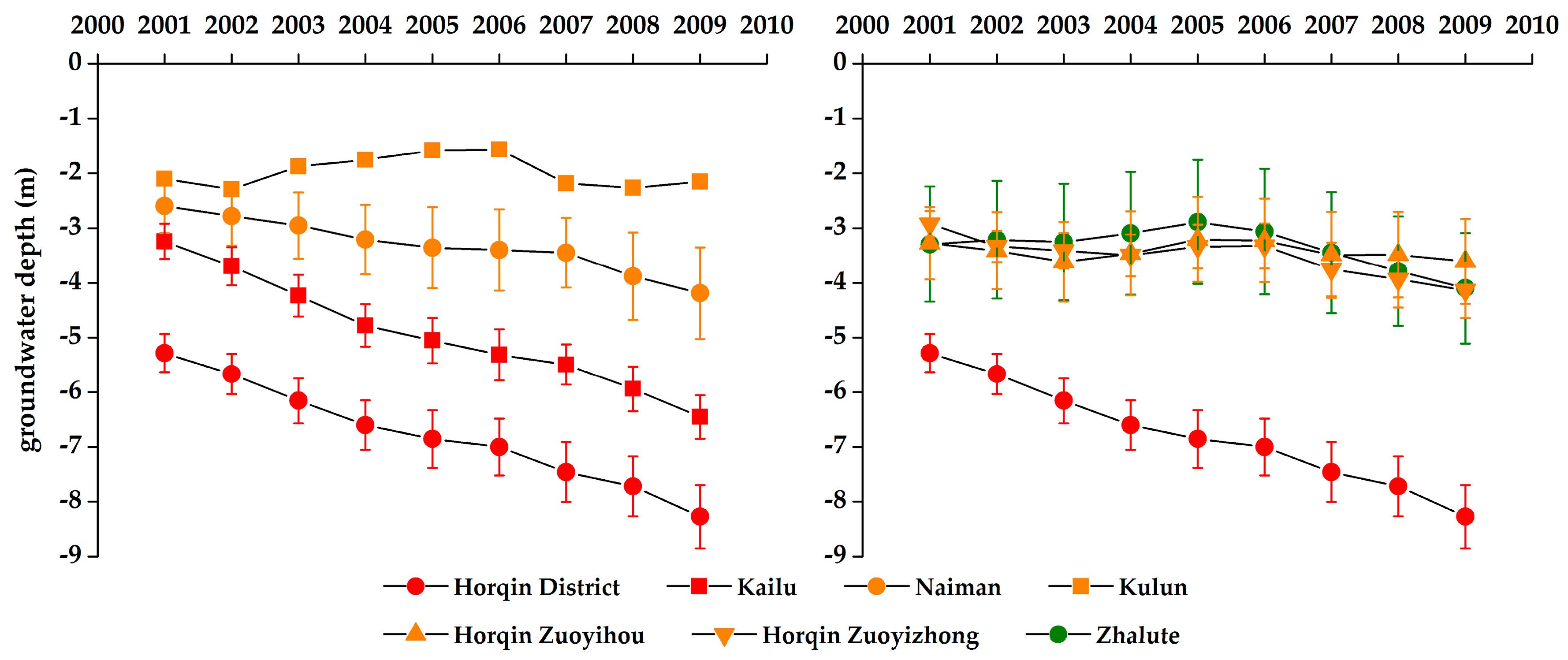
| County | (a) Mean Method | (b) MVC Method | ||||
|---|---|---|---|---|---|---|
| Slope | R2 | F Value | Slope | R2 | F Value | |
| Horqin District | 0.005 | 0.667 ** | 28.034 | 0.004 | 0.410 ** | 9.732 |
| Kailu | 0.007 | 0.862 ** | 87.107 | 0.006 | 0.660 ** | 27.226 |
| Naiman | 0.006 | 0.762 ** | 44.832 | 0.005 | 0.440 ** | 11.002 |
| Kulun | 0.005 | 0.605 ** | 21.479 | 0.003 | 0.183 | 3.130 |
| Aohan | 0.006 | 0.572 ** | 18.731 | 0.004 | 0.187 | 3.224 |
| Horqin Zuoyihou | 0.004 | 0.529 ** | 15.697 | 0.003 | 0.153 | 2.528 |
| Horqin Zuoyizhong | 0.006 | 0.550 ** | 17.087 | 0.004 | 0.221 | 3.976 |
| Horqin Youyizhong | 0.004 | 0.236 | 4.328 | 0.002 | 0.089 | 1.374 |
| Zhalute | 0.004 | 0.251 * | 4.682 | 0.002 | 0.027 | 0.394 |
| Ar Horqin | 0.003 | 0.149 | 2.449 | 0.000 | 0.000 | 0.005 |
| Balinzuo | 0.001 | 0.039 | 0.569 | −0.003 | 0.049 | 0.729 |
| Balinyou | 0.001 | 0.016 | 0.229 | −0.003 | 0.047 | 0.693 |
| Wengniute | 0.003 | 0.293 * | 5.807 | 0.001 | 0.028 | 0.403 |
| Huolinguole | 0.002 | 0.065 | 0.975 | 0.000 | 0.005 | 0.071 |
| Improved | Degraded | |||||
|---|---|---|---|---|---|---|
| Greatly | Slightly | Significantly | Greatly | Slightly | Significantly | |
| Per-pixel slope | >0.008 | (0.003, 0.008] | ≤−0.008 | (−0.008, −0.003] | ||
| (a) Mean method | 15.9% | 41.7% | 44.7% | 0.6% | 4.2% | 2.2% |
| (b) MVC method | 13.6% | 27.4% | 19.1% | 4.6% | 14.4% | 4.3% |
| Period | Water Body | Mobile Sand Land | Semi-Mobile Sand Land | Semi-Fixed Sand Land | Grassland | Cropland | Woodland |
|---|---|---|---|---|---|---|---|
| the late 1980s | 956 | 2673 | 8884 | 6204 | 60,433 | 26,964 | 11,239 |
| 0.8% | 2.2% | 7.4% | 5.2% | 50.2% | 22.4% | 9.6% | |
| 2000 | 891 | 3490 | 8902 | 7093 | 56,357 | 31,423 | 11,927 |
| 0.7% | 2.9% | 7.4% | 5.9% | 46.8% | 26.1% | 9.9% | |
| 2005 | 815 | 3003 | 9296 | 6423 | 56,065 | 31,931 | 11,964 |
| 0.7% | 2.5% | 7.7% | 5.3% | 46.6% | 26.5% | 9.9% | |
| 2010 | 814 | 2593 | 8064 | 6225 | 55,756 | 32,118 | 12,014 |
| 0.7% | 2.2% | 6.7% | 5.2% | 46.3% | 26.7% | 10.0% | |
| 2015 | 527 | / | / | / | 45,478 | 34,072 | 18,995 |
| 0.4% | / | / | / | 37.8% | 28.3% | 15.8% |
| County | Economic Pattern | PI | CCF | ECRA | YG |
|---|---|---|---|---|---|
| Horqin District | AZ | 0.605 * | 0.548 * | 0.516 * | 0.622 * |
| Kailu | AZ | 0.793 ** | 0.804 ** | 0.731 ** | 0.830 ** |
| Naiman | APZ | 0.617 * | 0.633 ** | 0.561 * | 0.640 ** |
| Kulun | APZ | 0.388 | 0.529 * | 0.430 | 0.495 |
| Aohan | APZ | 0.581 * | 0.348 | 0.279 | 0.620 * |
| Wengniute | APZ | 0.182 | 0.147 | 0.277 | 0.476 |
| Horqin Zuoyihou | APZ | 0.411 | 0.279 | 0.344 | 0.440 |
| Horqin Zuoyizhong | APZ | 0.499 * | 0.396 | 0.487 | 0.337 |
| Horqin Youyizhong | PZ | 0.320 | 0.253 | 0.282 | 0.381 |
| Zhalute | PZ | 0.221 | 0.050 | −0.204 | 0.489 |
| Ar Horqin | PZ | 0.075 | −0.052 | −0.009 | 0.239 |
| Balinzuo | PZ | −0.188 | −0.096 | −0.387 | 0.171 |
| Balinyou | PZ | −0.139 | −0.426 | −0.196 | 0.387 |
| Huolinguole City | CM | −0.140 | −0.361 | −0.145 | −0.414 |
| Path xi to y | Correlation Coefficient | Direct Path Coefficient | Indirect Path Coefficient | Total | DC | ||||
|---|---|---|---|---|---|---|---|---|---|
| AP | YG | SG | |||||||
| YG | 0.766 | 1.036 | −0.270 | −0.270 | 0.514 | ||||
| SG | −0.059 | −0.559 | 0.500 | 0.500 | −0.247 | ||||
| APZ | P | YG | WI | ECRA | |||||
| P | 0.502 | 0.443 | 0.096 | −0.051 | 0.013 | 0.058 | 0.249 | ||
| YG | 0.433 | 0.293 | 0.145 | −0.040 | 0.034 | 0.140 | 0.168 | ||
| WI | 0.142 | 0.305 | −0.074 | −0.039 | −0.050 | −0.163 | −0.006 | ||
| ECRA | 0.200 | 0.197 | 0.030 | 0.051 | −0.078 | 0.003 | 0.040 | ||
| PZ | P | YG | CCF | ||||||
| P | 0.519 | 0.307 | 0.383 | −0.172 | 0.212 | 0.224 | |||
| YG | 0.502 | 0.596 | 0.197 | −0.292 | −0.094 | 0.243 | |||
| CCF | 0.300 | −0.349 | 0.151 | 0.498 | 0.649 | −0.331 | |||
© 2017 by the authors. Licensee MDPI, Basel, Switzerland. This article is an open access article distributed under the terms and conditions of the Creative Commons Attribution (CC BY) license ( http://creativecommons.org/licenses/by/4.0/).
Share and Cite
Lian, J.; Zhao, X.; Li, X.; Zhang, T.; Wang, S.; Luo, Y.; Zhu, Y.; Feng, J. Detecting Sustainability of Desertification Reversion: Vegetation Trend Analysis in Part of the Agro-Pastoral Transitional Zone in Inner Mongolia, China. Sustainability 2017, 9, 211. https://doi.org/10.3390/su9020211
Lian J, Zhao X, Li X, Zhang T, Wang S, Luo Y, Zhu Y, Feng J. Detecting Sustainability of Desertification Reversion: Vegetation Trend Analysis in Part of the Agro-Pastoral Transitional Zone in Inner Mongolia, China. Sustainability. 2017; 9(2):211. https://doi.org/10.3390/su9020211
Chicago/Turabian StyleLian, Jie, Xueyong Zhao, Xin Li, Tonghui Zhang, Shaokun Wang, Yongqing Luo, Yangchun Zhu, and Jing Feng. 2017. "Detecting Sustainability of Desertification Reversion: Vegetation Trend Analysis in Part of the Agro-Pastoral Transitional Zone in Inner Mongolia, China" Sustainability 9, no. 2: 211. https://doi.org/10.3390/su9020211






